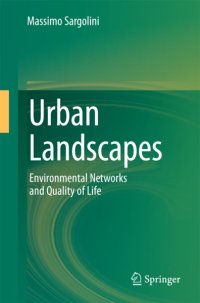
Ebook: Urban Landscapes: Environmental Networks and Quality of Life
Author: Massimo Sargolini (auth.)
- Genre: Technique
- Tags: Sustainable Development, Landscape/Regional and Urban Planning, Urbanism, Quality of Life Research
- Year: 2013
- Publisher: Springer-Verlag Mailand
- Edition: 1
- Language: English
- pdf
Today, more than 50% of the world’s population lives in cities and is subject to particular environmental and economic impacts against the backdrop of an evolving planetary crisis. This book explores the intimate relationship between the quality of life of city dwellers and the quality of urban landscapes, including those regenerated through green spaces and environmental networks. Starting from the concept of “landscape” as defined by the European Landscape Convention (i.e. "an area, perceived by people, whose character is the result of the action and interaction of natural and/or human factors"), it expands upon, in particular, the interactions between the different biotic and abiotic components that contribute to the quality of the landscape and the environment. In the first part of the book, the author examines fundamental concepts and discusses a variety of relevant topics, such as the city under transformation, waste spaces, smart communities, regeneration programs, the role of environmental networks, and new instruments for decision making. The second part is devoted to a case study of the Italian Adriatic city that highlights the need for interdisciplinary interaction among researchers in apparently disparate fields, including ecology, forest botany, chemistry, biology, geology, sociology, economics, architecture, and engineering.
Today, more than 50% of the world’s population lives in cities and is subject to particular environmental and economic impacts against the backdrop of an evolving planetary crisis. This book explores the intimate relationship between the quality of life of city dwellers and the quality of urban landscapes, including those regenerated through green spaces and environmental networks. Starting from the concept of “landscape” as defined by the European Landscape Convention (i.e. "an area, perceived by people, whose character is the result of the action and interaction of natural and/or human factors"), it expands upon, in particular, the interactions between the different biotic and abiotic components that contribute to the quality of the landscape and the environment. In the first part of the book, the author examines fundamental concepts and discusses a variety of relevant topics, such as the city under transformation, waste spaces, smart communities, regeneration programs, the role of environmental networks, and new instruments for decision making. The second part is devoted to a case study of the Italian Adriatic city that highlights the need for interdisciplinary interaction among researchers in apparently disparate fields, including ecology, forest botany, chemistry, biology, geology, sociology, economics, architecture, and engineering.